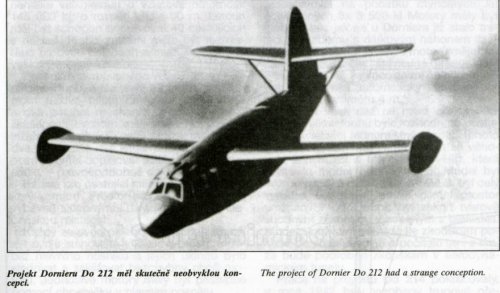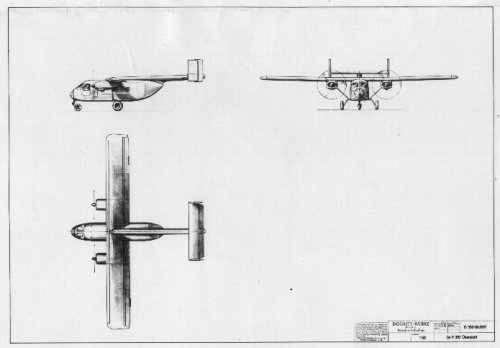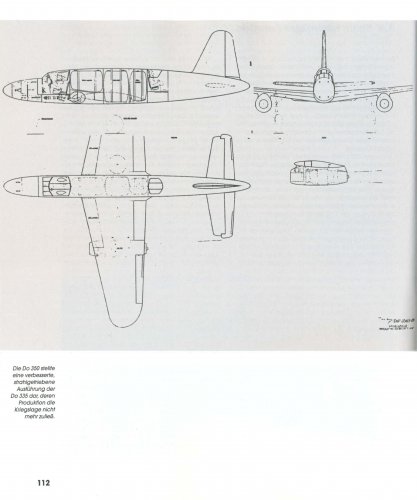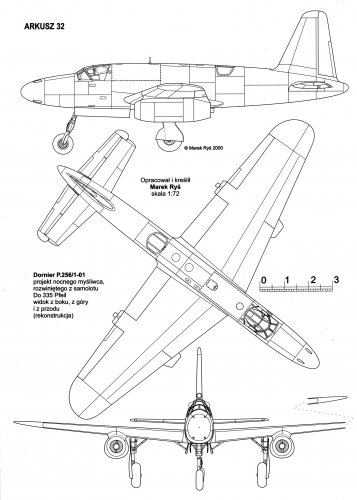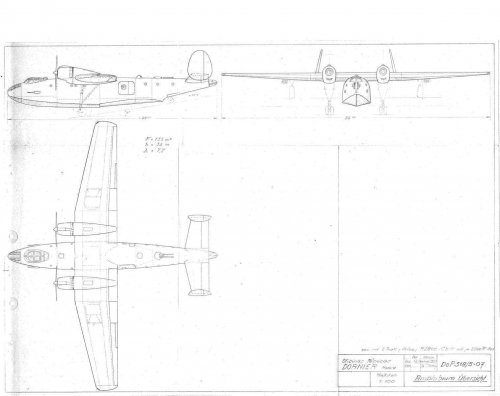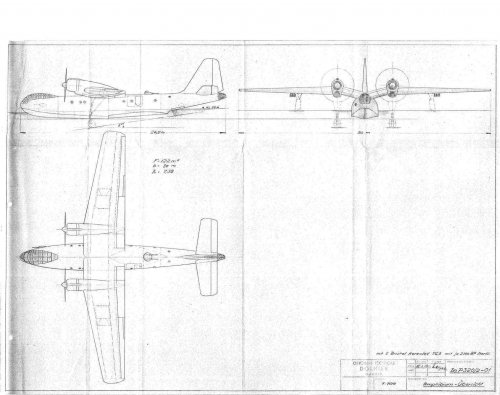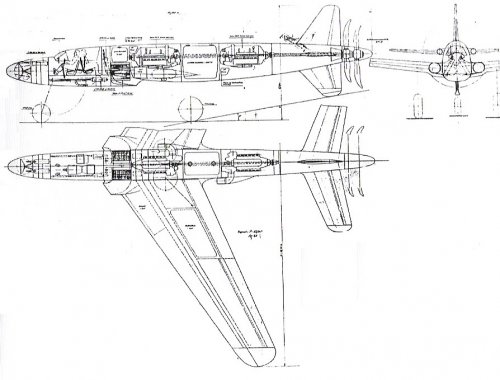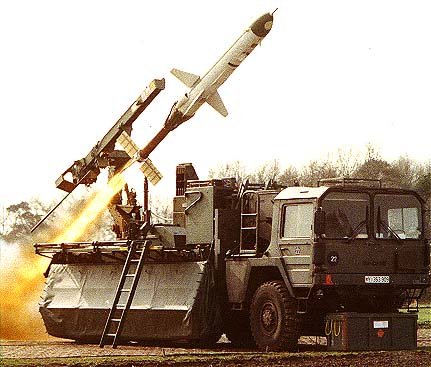You are using an out of date browser. It may not display this or other websites correctly.
You should upgrade or use an alternative browser.
You should upgrade or use an alternative browser.
Dornier Project Designations
Hello there  ,
,
this is what I know about Dornier projects. If you know more, please fill in the gaps:
Do P.30 4 engined transport
Do P.59 Fighter project
Do P.85 Sea-Stuka, 2 DB601G, similar to Do217, with floats
Do P.93 Early design for the Do 214
Do P.174 Do 216
Do P.184 Transport, parallel development to the BV 144
Do P.192 Do 214
Do P.231 High-speed bomber
Do P.232 mixed propulsion fighter
Do P.238 Fighter project/Do 435
Do P.247/6 Fighter-bomber (Jabo), pusher propeller
Do P.252 Night-fighter, 2 Jumo 213
Do P.254 Mixed propulsion jet-piston
Do P.256/1 Jet heavy fighter
Do P.273 High altitude fighter
Do P.350 Heavy night-fighter
Do jet small fighter ( prone pilot )
Do Jet "Canard Fighter"
Do jet "Schnellbomber I/II"
this is what I know about Dornier projects. If you know more, please fill in the gaps:
Do P.30 4 engined transport
Do P.59 Fighter project
Do P.85 Sea-Stuka, 2 DB601G, similar to Do217, with floats
Do P.93 Early design for the Do 214
Do P.174 Do 216
Do P.184 Transport, parallel development to the BV 144
Do P.192 Do 214
Do P.231 High-speed bomber
Do P.232 mixed propulsion fighter
Do P.238 Fighter project/Do 435
Do P.247/6 Fighter-bomber (Jabo), pusher propeller
Do P.252 Night-fighter, 2 Jumo 213
Do P.254 Mixed propulsion jet-piston
Do P.256/1 Jet heavy fighter
Do P.273 High altitude fighter
Do P.350 Heavy night-fighter
Do jet small fighter ( prone pilot )
Do Jet "Canard Fighter"
Do jet "Schnellbomber I/II"
- Joined
- 26 May 2006
- Messages
- 33,572
- Reaction score
- 13,700
P.360;
http://www.secretprojects.co.uk/forum/index.php/topic,872.msg23135/highlight,dornier+p.html#msg23135
P.340;
http://www.secretprojects.co.uk/forum/index.php/topic,758.msg6305/highlight,dornier+p.html#msg6305
P.326;
http://www.secretprojects.co.uk/forum/index.php/topic,645.msg15055/highlight,dornier+p.html#msg15055
P.375;
http://www.secretprojects.co.uk/forum/index.php/topic,206.msg27090/highlight,dornier+p.html#msg27090
http://www.secretprojects.co.uk/forum/index.php/topic,872.msg23135/highlight,dornier+p.html#msg23135
P.340;
http://www.secretprojects.co.uk/forum/index.php/topic,758.msg6305/highlight,dornier+p.html#msg6305
P.326;
http://www.secretprojects.co.uk/forum/index.php/topic,645.msg15055/highlight,dornier+p.html#msg15055
P.375;
http://www.secretprojects.co.uk/forum/index.php/topic,206.msg27090/highlight,dornier+p.html#msg27090
Here I am again  !
!
Dornier projects:
P144
P149
P150
P151
P152
P155
All of this projects stem from the company`s experiments with pressure cabins using the Do217 airframe. P144 is most curious since it uses 3 BMW 801, two of them in the wings, greatly projecting from the leading edge and with ducted spinners, but with a third in the tail, a pusher !!!
!!!
Dornier projects:
P144
P149
P150
P151
P152
P155
All of this projects stem from the company`s experiments with pressure cabins using the Do217 airframe. P144 is most curious since it uses 3 BMW 801, two of them in the wings, greatly projecting from the leading edge and with ducted spinners, but with a third in the tail, a pusher
- Joined
- 26 May 2006
- Messages
- 33,572
- Reaction score
- 13,700
Wurger said:Here I am again!
Dornier projects:
P144
P149
P150
P151
P152
P155
All of this projects stem from the company`s experiments with pressure cabins using the Do217 airframe. P144 is most curious since it uses 3 BMW 801, two of them in the wings, greatly projecting from the leading edge and with ducted spinners, but with a third in the tail, a pusher!!!
My dear Wurger,
do you mean the P153 and not P.152 ?,that is because the P153 was developed
from P149 as twin-engined medium bomber project.
richard
ACCESS: Top Secret
- Joined
- 1 May 2006
- Messages
- 578
- Reaction score
- 133
Bonjour
P 209 : Night fighter looking like a Do 217 with tricycle UC
P 215 : Bomber .2xDB 613 ,pusher (coaxial) .
P 222 : Stuka
P 223 : Stuka
P 217 : Do 335 derivative
Are you sure about the P 350 being pre-war ?
The Do 212 is not a project : it was built on the swiss side of the "Bodensee" ,not far from Lindau ...
Cheers
Richard
P 209 : Night fighter looking like a Do 217 with tricycle UC
P 215 : Bomber .2xDB 613 ,pusher (coaxial) .
P 222 : Stuka
P 223 : Stuka
P 217 : Do 335 derivative
Are you sure about the P 350 being pre-war ?
The Do 212 is not a project : it was built on the swiss side of the "Bodensee" ,not far from Lindau ...
Cheers
Richard
Hello guys,
many thanks for your contributions !
!
The Dornier P.350 reference was taken from Manfred Griehl`s "Jet Planes of the Third Reich". The newest list was taken from Volker Koos`s "Dornier, von den Anfängen bis 1945". This author is always well fundamented, so perhaps that suggestion, Hesham, relates to another medium bomber in that same series. I cannot tell you more.
Do guys have more data on this projects? I will post what I have in the "Early Secret Projects". See you there! Meanwhile, every new project is welcome here too .
.
many thanks for your contributions
The Dornier P.350 reference was taken from Manfred Griehl`s "Jet Planes of the Third Reich". The newest list was taken from Volker Koos`s "Dornier, von den Anfängen bis 1945". This author is always well fundamented, so perhaps that suggestion, Hesham, relates to another medium bomber in that same series. I cannot tell you more.
Do guys have more data on this projects? I will post what I have in the "Early Secret Projects". See you there! Meanwhile, every new project is welcome here too
Maveric
Fight for yor Right!
- Joined
- 14 January 2007
- Messages
- 2,180
- Reaction score
- 746
richard said:Thank you : the P 350 I knew had a different fuselage .
Have you a picture of the 3-engined forerunner , the P.346 ?
Sorry, nothing about the P.346... :-\
- Joined
- 13 August 2007
- Messages
- 7,880
- Reaction score
- 9,007
Some of post War Designations
Dornier P 406 1960s crane helicopter for payload of 40 tons, based on Do 32 technology
Dornier P 410 1968 study for attact Helicopter in size of Eurocopter
Dornier P 621 Study for a re-usable sounding rocket
Dornier ELGO aka Europa IIID a modular lanuch rocket concept
Non Aircraft products by Dornier
I post the names and abbreviation for identification
Dornier-SAR (Synthetic Aperture Radar) used on European Remote-Sensing Satellite and in C-130 of Luftwaffe WTD 61
Dornier-FFB Faltfestbrücke (makeshift bridge) R&D and bulid by Dornier-werke for German Army
Dornier-Nierenlitotripter aka Nierensteinzertrümmerer (Extracorporeal shock wave lithotripsy)
still build by Dornier MedTech Systems GmbH, but start as study for F-104G all weather Supersonic capacity at Dornier-Werke
Dornier-Delta (this is a Prototype for mini Car !)

Dornier P 406 1960s crane helicopter for payload of 40 tons, based on Do 32 technology
Dornier P 410 1968 study for attact Helicopter in size of Eurocopter
Dornier P 621 Study for a re-usable sounding rocket
Dornier ELGO aka Europa IIID a modular lanuch rocket concept
Non Aircraft products by Dornier
I post the names and abbreviation for identification
Dornier-SAR (Synthetic Aperture Radar) used on European Remote-Sensing Satellite and in C-130 of Luftwaffe WTD 61
Dornier-FFB Faltfestbrücke (makeshift bridge) R&D and bulid by Dornier-werke for German Army
Dornier-Nierenlitotripter aka Nierensteinzertrümmerer (Extracorporeal shock wave lithotripsy)
still build by Dornier MedTech Systems GmbH, but start as study for F-104G all weather Supersonic capacity at Dornier-Werke
Dornier-Delta (this is a Prototype for mini Car !)

Hi all,
about Dornier post-war developments, we can add:
Do 24/72
Do 25 developed with AISA
Do 27 single-engined STOL
Do 28 twin-engined STOL (and Skyservant versions)
Do 31 VTOL transport
Do 32 (helicopter if I'm right)
LTA light transport aircraft demonstrator
NWT wing technology demonstrator
Do 128 Skyservant
Do 228 utility twin
ATT or Do 24TT
Do 328 regional turboprop or turbofan
Nico
about Dornier post-war developments, we can add:
Do 24/72
Do 25 developed with AISA
Do 27 single-engined STOL
Do 28 twin-engined STOL (and Skyservant versions)
Do 31 VTOL transport
Do 32 (helicopter if I'm right)
LTA light transport aircraft demonstrator
NWT wing technology demonstrator
Do 128 Skyservant
Do 228 utility twin
ATT or Do 24TT
Do 328 regional turboprop or turbofan
Nico
- Joined
- 9 October 2009
- Messages
- 21,147
- Reaction score
- 12,249
According to this: http://en.wikipedia.org/wiki/Z%C3%BCndapp_Janus
The Dornier-Delta was a prototype for the Zündapp Janus.
The Dornier-Delta was a prototype for the Zündapp Janus.
- Joined
- 26 May 2006
- Messages
- 33,572
- Reaction score
- 13,700
Hi,
P.378 was a civilian V/STOL plane.Design based on the Do 31.
Start and stop of the project 1966.
P.407 designed 1966,at the end of the development, the engineers had been
studying a fast helicopter for 35 passengers and a cruising speed of 500
km/h (270 kt).
http://www.aiaa.org/tc/vstol/unbuilt/index.htm
P.378 was a civilian V/STOL plane.Design based on the Do 31.
Start and stop of the project 1966.
P.407 designed 1966,at the end of the development, the engineers had been
studying a fast helicopter for 35 passengers and a cruising speed of 500
km/h (270 kt).
http://www.aiaa.org/tc/vstol/unbuilt/index.htm
- Joined
- 25 June 2009
- Messages
- 14,141
- Reaction score
- 4,333
Maveric
Fight for yor Right!
- Joined
- 14 January 2007
- Messages
- 2,180
- Reaction score
- 746
Found your reference...Wurger said:Hello guys,
many thanks for your contributions!
The Dornier P.350 reference was taken from Manfred Griehl`s "Jet Planes of the Third Reich". The newest list was taken from Volker Koos`s "Dornier, von den Anfängen bis 1945". This author is always well fundamented, so perhaps that suggestion, Hesham, relates to another medium bomber in that same series. I cannot tell you more.
Do guys have more data on this projects? I will post what I have in the "Early Secret Projects". See you there! Meanwhile, every new project is welcome here too.
On the pic you can find the Designation DoP.256, but I have no other reference for a RLM-Number 350.
Servus Maveric
Attachments
- Joined
- 22 January 2006
- Messages
- 4,114
- Reaction score
- 1,695
Found a few words about the P.346 but still no drawings
Source: RAF Flying Review Vol. XVII, Nº4
"Dornier is currently working on a new three-engined ten/fifteen seat utility transport intended primarily for use in undeveloped areas. The aircraft will feature rear ramp"
Source: RAF Flying Review Vol. XVII, Nº4
"Dornier is currently working on a new three-engined ten/fifteen seat utility transport intended primarily for use in undeveloped areas. The aircraft will feature rear ramp"
- Joined
- 26 May 2006
- Messages
- 33,572
- Reaction score
- 13,700
Also I find the Dornier P.362 in NASA report,it assigned to Do-31E in wind tunnel
research;
http://ntrs.nasa.gov/archive/nasa/casi.ntrs.nasa.gov/19740012556_1974012556.pdf
research;
http://ntrs.nasa.gov/archive/nasa/casi.ntrs.nasa.gov/19740012556_1974012556.pdf
Attachments
- Joined
- 26 May 2006
- Messages
- 33,572
- Reaction score
- 13,700
- Joined
- 28 January 2008
- Messages
- 631
- Reaction score
- 480
I had an unidentified image stuck on my drive for ages and have finally found an identical one in Griehl's Dornier book.
Its the Dornier Do P.252 day and night fighter from 1945...
Dornier P.252/1
2 Crew
2 x Jumo 213J
Wingspan 18.40 m
Length 17.3 m
Height 5.25 m
Wing Area 55.00 sq m
Take-off Weight 10,500 kg
EmptyWeight 8,290 kg
Ceiling: 13,400 m
Range 1,525 km
Armament 3 x MK 108 or 2 MG213C
Source:
Dornier Flugzeuge Seit 1915 (Manfred Griehl) Motorbuch ISBN 9783613031067
Its the Dornier Do P.252 day and night fighter from 1945...
Dornier P.252/1
2 Crew
2 x Jumo 213J
Wingspan 18.40 m
Length 17.3 m
Height 5.25 m
Wing Area 55.00 sq m
Take-off Weight 10,500 kg
EmptyWeight 8,290 kg
Ceiling: 13,400 m
Range 1,525 km
Armament 3 x MK 108 or 2 MG213C
Source:
Dornier Flugzeuge Seit 1915 (Manfred Griehl) Motorbuch ISBN 9783613031067
Attachments
- Joined
- 9 October 2009
- Messages
- 21,147
- Reaction score
- 12,249
http://www.dtic.mil/docs/citations/ADA347583GEFAMOS
GEFAMOS is the designation coined by Dornier for a
battlefield reconnaissance and target acquisition system
as a successor to the Argus tethered rotor platform or the
free flying PRIAMOS (Primaer-Aufklaerungsmittel und
Zielortungssystem [Primary Reconnaissance and Target
Acquisition System]) as suggested by Dornier after cancellation
of the Argus project. While Argus, just like
PRIAMOS, tended to emphasize primary reconnaissance,
GEFAMOS limits itself more to secondary reconnaissance
(target reconnaissance) now that the Air Force
has become responsible for primary reconnaissance.
With its own funds Dornier is now planning to build a
demonstration launch vehicle for an initial flight in the
summer of 1989. The American QH-50 helicopter drone
(formerly used as a torpedo launcher) is supposed to be
used as the aircraft; for the radar sensor, France will
make available a radar sensor derived from the ORCHIDEE
system (helicopter PUMA with battlefield radar)—
the ORCHIDEE radar in turn is an advanced version of
the radar used by ARGUS. The GEFAMOS aircraft has
a mass of about 1,000 kg; its reconnaissance range at an
altitude of about 3,500 meters is about 100 km. This
makes it more effective than Argus which, as a 300-
meter-high tethered platform, at ranges above 40 km had
an insufficient radar angle of incidence and consequently
caused excessive radar masking.
The question now arises to what extent the Army, after
the CL-289 and KZO, can still finance a third reconnaissance
resource.
12628
- Joined
- 9 October 2009
- Messages
- 21,147
- Reaction score
- 12,249
Grey Havoc said:Apophenia said:Canadair CL-289 - UAV, intermediate-range surveillance drone, 1971
Interestingly, that designation seems to have been reused for a late 1980s Canadair-Dornier reconnaissance/artillery spotter drone program for the German and French militaries. Or was it perhaps a revival of the same design?
http://www.dtic.mil/docs/citations/ADA347583CL-289
The CL-289 drone is a joint Canadian-German-French
venture. It was developed by Canadair and Dornier
(with the share financed by the Federal Ministry of
Defense amounting to roughly DM280 million or about
75 percent), while France funded the development of
SAT's IR line scanner. The drone has been in serial
production for the Federal Republic (11 systems ordered
so far for corps and division artillery) and for France
(three systems) since 1987 with a delivery date between
1992 and 1995. Excluding the IR line scanner, Dornier
will handle about 50 percent of the work including final
assembly of the missiles, completion of the drone front
end, payload integration and responsibility for most of
the ground station. The drone system is designed to be
fully mobile and, therefore, requires considerable personnel
and vehicle resources—analysis of the quantity of
information furnished by the drone alone requires five
vehicles. The T117 sustainer is supplied by KHD's
Aerospace Technology branch and the optical camera
comes from Zeiss.
The CL-289 flight almost hugs the terrain. The IR
scanner and the optical camera are activated at predetermined
points, and line scanner data can be transmitted
by radio to the ground station up to a distance of
roughly 70 km (depending on flight altitude). Special
emphasis is placed on rapid evaluation and dissemination
of reconnaissance data—values of 30 minutes or less
are quoted for the period between "drone above target"
and "target data available to artillery."
An increase in combat effectiveness is already being
considered. This could include increased range, integration
of a radar sensor and reductions in personnel
requirements by even more automation.
EDIT: Via army-technology.com:
Attachments
- Joined
- 9 October 2009
- Messages
- 21,147
- Reaction score
- 12,249
Jemiba said:A bit of nitpicking maybe, but GEFAMOS, although called a "designation" in the article, to my
opinion is rather a program, not a designation in our sense.
Hmmm. Could the full name, Gefechtsfeld- Aufklaerungsmittel und -Zielortungssystem, be considered a true or interim designation then?
- Joined
- 11 March 2006
- Messages
- 8,633
- Reaction score
- 3,489
Hard to tell, mostly a designation fits into a designation system and post-war Dornier
behaviour principally was no exception from that rule keeping on with P-numbers for
projects and Do-numbers until the Do 328. "GEFAMOS" just is a short form for "Ge-
fechtsfeldaufklärungsmittel/Ortungssystem"" (battlefield reconnaissance and detection
asset) and to my opinion more a description, that could have been used by contenders
for their own designs as well.
behaviour principally was no exception from that rule keeping on with P-numbers for
projects and Do-numbers until the Do 328. "GEFAMOS" just is a short form for "Ge-
fechtsfeldaufklärungsmittel/Ortungssystem"" (battlefield reconnaissance and detection
asset) and to my opinion more a description, that could have been used by contenders
for their own designs as well.
- Joined
- 26 May 2006
- Messages
- 33,572
- Reaction score
- 13,700
Wurger said:Do P.350 Heavy night-fighter
My dear Wurger,
in reply # 14.my dear Richard explained that,the Do P.350 was a transport aircraft not a fighter,what is your source about your Info ?.
Last edited:
- Joined
- 26 May 2006
- Messages
- 33,572
- Reaction score
- 13,700
Wurger said:Hello guys,
many thanks for your contributions!
The Dornier P.350 reference was taken from Manfred Griehl`s "Jet Planes of the Third Reich". The newest list was taken from Volker Koos`s "Dornier, von den Anfängen bis 1945". This author is always well fundamented, so perhaps that suggestion, Hesham, relates to another medium bomber in that same series. I cannot tell you more.
Do guys have more data on this projects? I will post what I have in the "Early Secret Projects". See you there! Meanwhile, every new project is welcome here too.
Definitely it was a misprint and they meant P.250 ?,the series 300 was appeared after WWII.
- Joined
- 26 May 2006
- Messages
- 33,572
- Reaction score
- 13,700
Do P.350 Heavy night-fighter
It's still no more Info or drawing ?.
Similar threads
-
-
-
Secret Projects of the Luftwaffe by Dan Sharp
- Started by newsdeskdan
- Replies: 49
-
-

